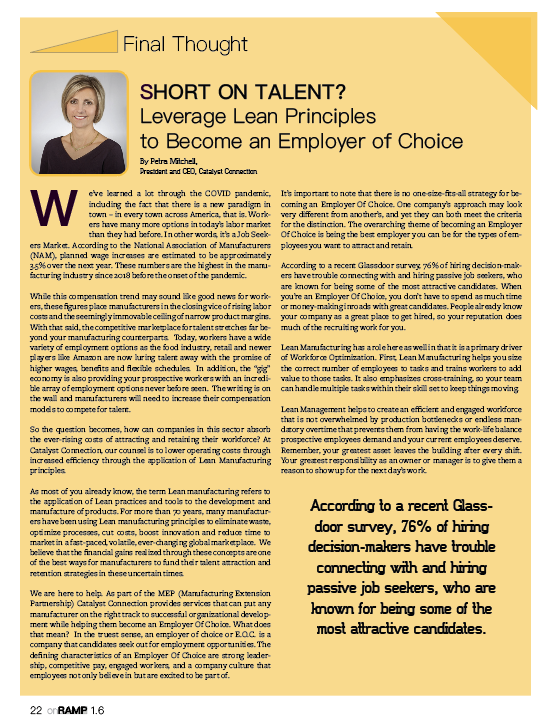Short on Talent? Leverage Lean Principles to Become an Employer of Choice
By Petra Mitchell, Catalyst Connection
 We’ve learned a lot through the COVID pandemic, including the fact that there is a new paradigm in town – in every town across America, that is. Workers have many more options in today’s labor market than they had before. In other words, it’s a Job Seekers Market. According to the National Association of Manufacturers (NAM), planned wage increases are estimated to be approximately 3.5% over the next year. These numbers are the highest in the manufacturing industry since 2018 before the onset of the pandemic.
We’ve learned a lot through the COVID pandemic, including the fact that there is a new paradigm in town – in every town across America, that is. Workers have many more options in today’s labor market than they had before. In other words, it’s a Job Seekers Market. According to the National Association of Manufacturers (NAM), planned wage increases are estimated to be approximately 3.5% over the next year. These numbers are the highest in the manufacturing industry since 2018 before the onset of the pandemic.
While this compensation trend may sound like good news for workers, these figures place manufacturers in the closing vice of rising labor costs and the seemingly immovable ceiling of narrow product margins.
With that said, the competitive marketplace for talent stretches far beyond your manufacturing counterparts. Today, workers have a wide variety of employment options as the food industry, retail and newer players like Amazon are now luring talent away with the promise of higher wages, benefits and flexible schedules. In addition, the “gig” economy is also providing your prospective workers with an incredible array of employment options never before seen. The writing is on the wall and manufacturers will need to increase their compensation models to compete for talent.
So the question becomes, how can companies in this sector absorb the ever-rising costs of attracting and retaining their workforce? At Catalyst Connection, our counsel is to lower operating costs through increased efficiency through the application of Lean Manufacturing principles.
As most of you already know, the term Lean manufacturing refers to the application of Lean practices and tools to the development and manufacture of products. For more than 70 years, many manufacturers have been using Lean manufacturing principles to eliminate waste, optimize processes, cut costs, boost innovation and reduce time to market in a fast-paced, volatile, ever-changing global marketplace. We believe that the financial gains realized through these concepts are one of the best ways for manufacturers to fund their talent attraction and retention strategies in these uncertain times.
We are here to help. As part of the MEP (Manufacturing Extension Partnership) Catalyst Connection provides services that can put any manufacturer on the right track to successful organizational development while helping them become an Employer Of Choice. What does that mean? In the truest sense, an employer of choice or E.O.C. is a company that candidates seek out for employment opportunities. The defining characteristics of an Employer Of Choice are strong leadership, competitive pay, engaged workers, and a company culture that employees not only believe in but are excited to be part of.
We are here to help. As part of the MEP (Manufacturing Extension Partnership) Catalyst Connection provides services that can put any manufacturer on the right track to successful organizational development while helping them become an Employer Of Choice.
It’s important to note that there is no one-size-fits-all strategy for becoming an Employer Of Choice. One company’s approach may look very different from another’s, and yet they can both meet the criteria for the distinction. The overarching theme of becoming an Employer Of Choice is being the best employer you can be for the types of employees you want to attract and retain.
According to a recent Glassdoor survey, 76% of hiring decision-makers have trouble connecting with and hiring passive job seekers, who are known for being some of the most attractive candidates. When you’re an Employer Of Choice, you don’t have to spend as much time or money-making inroads with great candidates. People already know your company as a great place to get hired, so your reputation does much of the recruiting work for you.
Lean Manufacturing has a role here as well in that it is a primary driver of Workforce Optimization. First, Lean Manufacturing helps you size the correct number of employees to tasks and trains workers to add value to those tasks. It also emphasizes cross-training, so your team can handle multiple tasks within their skill set to keep things moving.
Lean Management helps to create an efficient and engaged workforce that is not overwhelmed by production bottlenecks or endless mandatory overtime that prevents them from having the work-life balance prospective employees demand and your current employees deserve. Remember, your greatest asset leaves the building after every shift. Your greatest responsibility as an owner or manager is to give them a reason to show up for the next day’s work.